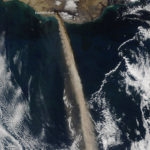OMG Irma. It is going through the Caribbean and slamming everything in its path. I’ve been getting updates from friends in the Virgin Islands and it sounds like it was harrowing. Thankfully they made it through which is the most important part (even though their stuff may not have). Other islands have not been so lucky.

This is a monster hurricane, fueled by warm waters in the Atlantic. Just to get a sense of how insane it got in Barbuda, here is the atmospheric data from a water level station there. The eye of the hurricane passed right overhead, which is why you see the insane drop in air pressure.

The wind speeds got up to 100 knots before the anemometer conked out. These winds are no joke, reports indicate that nearly every building on the island suffered damage, if not completely destroyed.
Update: The anemometer was completely destroyed.
Just saw highest wind speed I've ever seen on a WX ob. Anemometer at #Barbuda blew away after recording gust to 155 mph. #Irma pic.twitter.com/aNwT5i04gf
— Dan Satterfield (@wildweatherdan) September 6, 2017
Another problem for this tiny island with wide areas of low elevation, storm surge. Preliminary data shows it got up to 8 feet.
There’s also some oceanographic data from a buoy located south of St. John in the U.S. Virgin Islands that’s part of the Caribbean Integrated Coastal Ocean Observing System (CarICOOS) . Strong winds with gusts over 60 km/h accompany the pressure drop. 
The water temperature data is intermittent, but you can definitely see seawater getting colder. Wave and wind mixing churns up cold water from the deep ocean, causing surface water temperatures to drop. 
This buoy also has salinity data, and you can also see the effect of the mixing in the increase in salinity, as deeper saltier water is mixed to the surface. There is also a drop in salinity right before the hurricane hits which could be caused by rain freshening the sea surface or just fresher water being pushed past the buoy. From this data, you can’t distinguish the two causes.
Lastly, let’s take a look at the wave data. Wave heights got up to nearly 19 feet at the peak of the storm. Some waves might have been larger as this plot shows averaged values.
Another fascinating plot is the wave direction which shows how waves emanating from the center of the hurricane. The wave are coming steadily from the East (90 degrees on the compass rose) until the eye passes overhead, at which point the wave direction turns 180 degrees completely to the West (270 degrees on the compass rose).

That was my oceanographic quick look. I’m hunting around for some ocean robot data, as NOAA AOML deploys their gliders into hurricanes, but haven’t found any yet. I’ll post when I do. For another take on the storm, take a look at my friend Jyotika’s Tropical Storm Blog. It’s got good science and a good rundown of where Irma has been and where it’s going.
For those of you in Irma’s path, make sure you are prepared and take the necessary precautions to stay safe. Here are tips from NOAA’s Hurricane Preparedness site.





